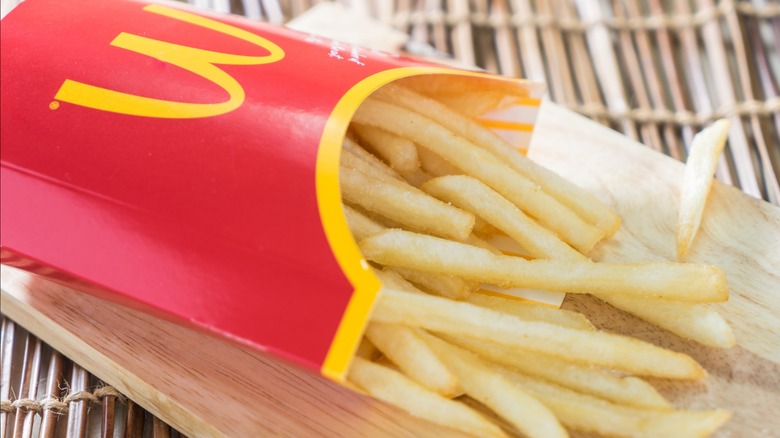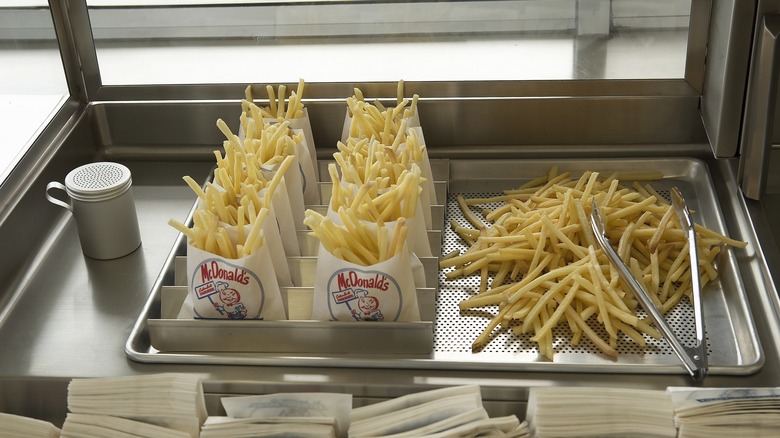How Were McDonald's Original Fries Different From Today's Version?
McDonald's famous fries were first introduced in 1949, replacing standard potato chips on the menu. Customers instantly fell in love with the addition, and it's still McDonald's best-selling item today. However, those salty spuds your grandparents ate aren't the same ones we enjoy now. And unless you've been munching on McDonald's fries since the '80s, you're probably not aware of the differences.
At first glance, the original and modern McDonald's fries appear similar. They've always maintained a slender shape, measuring approximately ¼ inch thick and 4 to 6 inches long. But if you were to taste the old and new versions side by side, you'd notice differences in texture and flavor (and for good reason). The company originally fried its potatoes in beef tallow but now uses 100% vegetable oil. The original fries also contained far simpler ingredients, while the modern recipe includes a few hard-to-pronounce chemicals.
McDonald's has been around for decades, and it's adjusted its fries recipe to keep up with consumer needs. It's only natural that dietary preferences and taste buds change over time. But while most McDonald's customers are only familiar with the chain's current fries, those who remember the original version say there's a stark contrast.
McDonald's original fries
When McDonald's fries first debuted in 1949, the chain charged just 10 cents per serving. At the time, it sourced its cooking oil from Interstate Foods. While many companies were using expensive machinery to hydrogenate oil (ensuring a longer shelf life), Interstate Foods chose to cut costs with beef tallow, which worked as a natural preservative. The shortening ended up being a mixture of 7% oil and 93% beef tallow.
The original fries contained popular ingredients of the era, including russet potatoes, sugar, Karo corn syrup, canola oil, hot water, and salt. After preparation, the fries were cooked in beef tallow shortening, which gave McDonald's fries their signature meaty flavor. It also contributed to the contrasting texture — the perfect combination of super crispy on the outside and soft and fluffy on the inside.
Compared to today's fries, fans report the original version had a more satisfying crunch and richer flavor. Unfortunately, not everyone was pleased with the inclusion of beef tallow. In the latter half of the 20th century, people became concerned that saturated fat was dangerously increasing cholesterol levels. To appease the masses, Interstate Foods replaced beef tallow with 100% vegetable oils in 1990. However, the fries were missing that quintessential beefy quality, forcing the chain to rework the entire recipe.
Today's version of McDonald's fries
Today, McDonald's Medium Fries cost around $4. They're made with potatoes, oil, dextrose (sugar), a color enhancer, and salt. The original recipe called only for russet potatoes, but the fast food chain now uses a blend of russet and Shepody. The oil used is a blend of canola, corn, and hydrogenated soybean oils. It also contains natural beef flavor made from hydrolyzed wheat and milk. This beef flavoring might be controversial, but it adds that distinctive meaty taste people associate with McDonald's fries.
The transition to today's fries wasn't entirely smooth. When McDonald's first revamped its recipe in 1990, it included more hydrogenated vegetable oils, which meant more trans fat. Once people realized trans fats were the real culprit, the chain adjusted its recipe again. Now, McDonald's Medium Fries contain just 1.5 grams of saturated fat, zero cholesterol, and zero trans fat.
McDonald's current fries tick many boxes for consumers, and they're world-famous for their salty, savory flavor. Although many claim they don't live up to the original version, it may not matter. Most consumers don't know what they're missing out on — if anything. And if you love these fast food fries and have leftovers lying around, we have just the trick to reheat McDonald's fries to crispy perfection.



